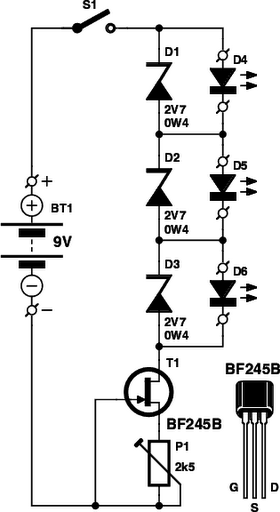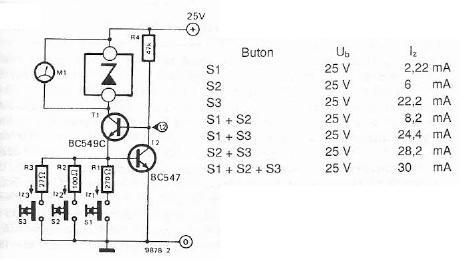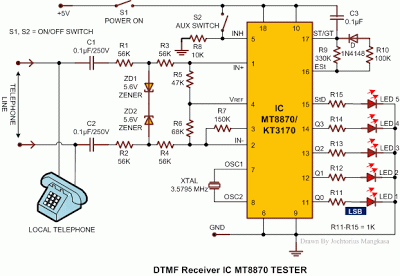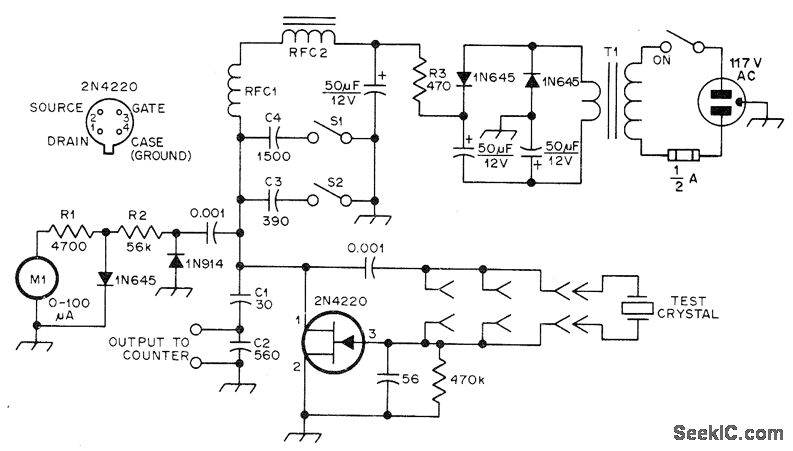
Fuse tester with LEDs
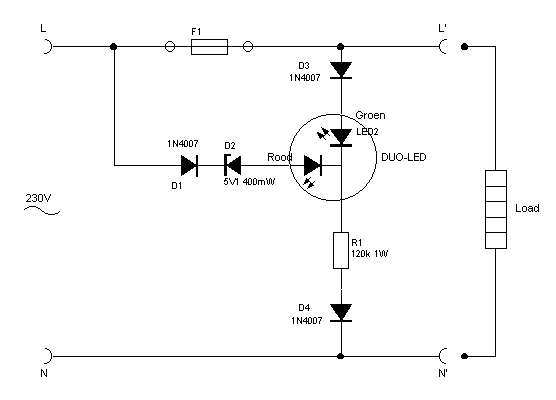
This indicator shows through a dual-LED see if a fuse is intact. The module is designed for 230 V AC. The green LED illuminates when the fuse is still good, the red lights when the fuse is broken. Perhaps the circuit to adjust for other voltages by changing the value of R1. More: R1 = 120 kOhm / 1 W LED2 = Duo LED green / red common cathode D1, D3, D4 = 1N4007 D2 = 5.1 V 400 mW Zener F1 = fuse
The described circuit functions as a fuse indicator using a dual LED configuration to visually represent the status of the fuse in a 230 V AC system. The primary components involved include a dual-color LED (LED2), resistors, diodes, and a fuse (F1) itself.
The dual LED, designated as LED2, has a common cathode configuration, allowing it to display two states: green for indicating that the fuse is intact, and red for signaling a blown fuse. The operation of this circuit relies on the correct biasing of the LED through the use of resistors and diodes.
The resistor R1, specified as 120 kOhm with a power rating of 1 W, serves as a current-limiting component for the LED. This resistor's value can be adjusted to accommodate different voltage levels, making the circuit adaptable for use with voltages other than the nominal 230 V AC. When the fuse (F1) is operational, the current flows through R1 and illuminates the green segment of the LED. Conversely, if the fuse is blown, the circuit configuration allows for the red segment of the LED to light up, indicating a fault condition.
The circuit also includes diodes D1, D3, and D4, which are 1N4007 types, functioning as rectifiers to ensure that the AC voltage is converted to a usable DC voltage for the LED operation. The Zener diode (D2), rated at 5.1 V and 400 mW, is included to provide voltage regulation and protect the LED from excessive voltage spikes that may occur in the circuit.
In summary, this fuse indicator circuit not only provides a straightforward visual indication of fuse status but also incorporates protective elements and adaptability for different voltage levels, making it a practical solution for monitoring fuse integrity in various applications.This indicator shows through a dual-LED see if a fuse is intact. The module is designed for 230 V AC. The green LED illuminates when the fuse is still good, the red lights when the fuse is broken. Perhaps the circuit to adjust for other voltages by changing the value of R1. R1 = 120 kOhm / 1 W LED2 = Duo LED green / red common cathode D1, D3, D4 = 1N4007 D2 = 5.1 V 400 mW Zener F1 = fuse 🔗 External reference
The described circuit functions as a fuse indicator using a dual LED configuration to visually represent the status of the fuse in a 230 V AC system. The primary components involved include a dual-color LED (LED2), resistors, diodes, and a fuse (F1) itself.
The dual LED, designated as LED2, has a common cathode configuration, allowing it to display two states: green for indicating that the fuse is intact, and red for signaling a blown fuse. The operation of this circuit relies on the correct biasing of the LED through the use of resistors and diodes.
The resistor R1, specified as 120 kOhm with a power rating of 1 W, serves as a current-limiting component for the LED. This resistor's value can be adjusted to accommodate different voltage levels, making the circuit adaptable for use with voltages other than the nominal 230 V AC. When the fuse (F1) is operational, the current flows through R1 and illuminates the green segment of the LED. Conversely, if the fuse is blown, the circuit configuration allows for the red segment of the LED to light up, indicating a fault condition.
The circuit also includes diodes D1, D3, and D4, which are 1N4007 types, functioning as rectifiers to ensure that the AC voltage is converted to a usable DC voltage for the LED operation. The Zener diode (D2), rated at 5.1 V and 400 mW, is included to provide voltage regulation and protect the LED from excessive voltage spikes that may occur in the circuit.
In summary, this fuse indicator circuit not only provides a straightforward visual indication of fuse status but also incorporates protective elements and adaptability for different voltage levels, making it a practical solution for monitoring fuse integrity in various applications.This indicator shows through a dual-LED see if a fuse is intact. The module is designed for 230 V AC. The green LED illuminates when the fuse is still good, the red lights when the fuse is broken. Perhaps the circuit to adjust for other voltages by changing the value of R1. R1 = 120 kOhm / 1 W LED2 = Duo LED green / red common cathode D1, D3, D4 = 1N4007 D2 = 5.1 V 400 mW Zener F1 = fuse 🔗 External reference

